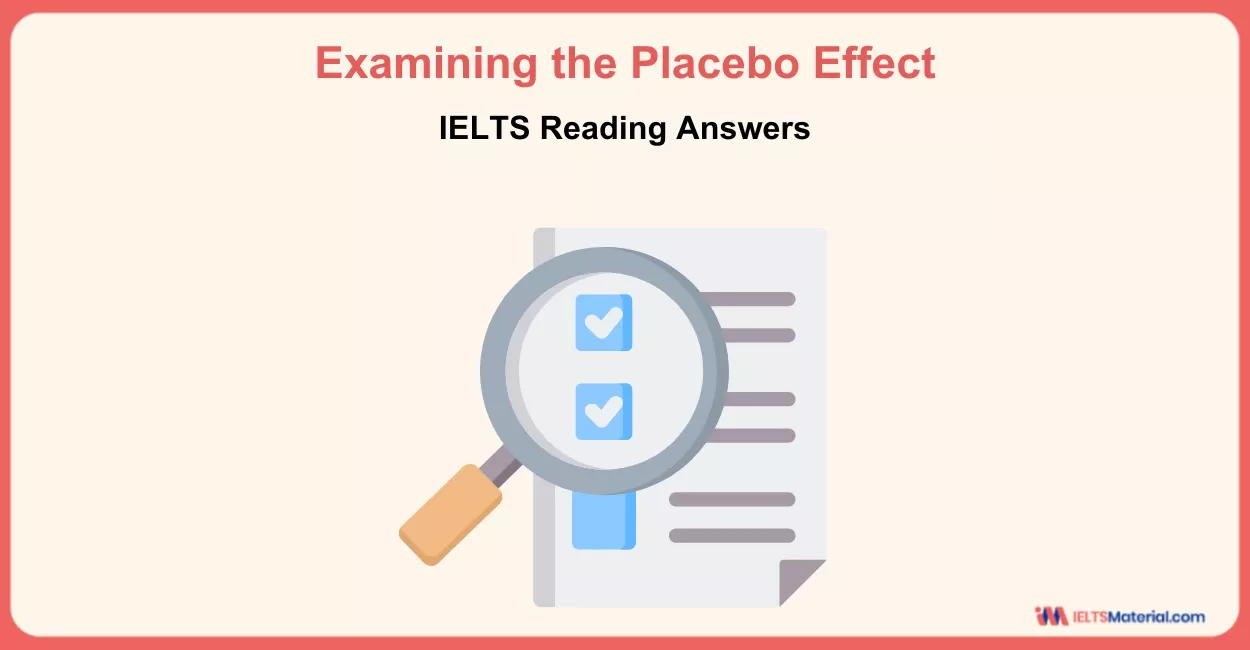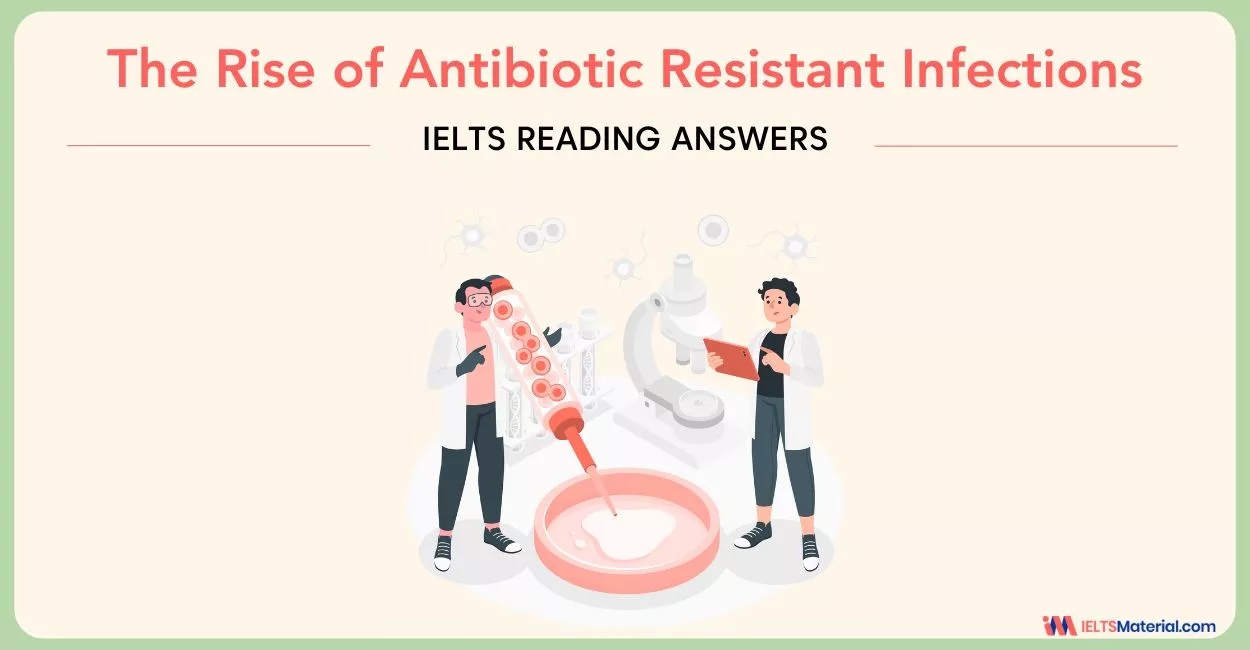The Rise of Antibiotic Resistant Infections - IELTS Reading Answers
13 min read
Updated On
-
Copy link
Get in-depth answers and explanations for the ‘The Rise of Antibiotic Resistant Infections IELTS Reading Answers’ here. Also, find out how to handle different types of IELTS Reading question types and strategies to enhance your reading skills for IELTS.
Table of Contents
- Passage for The Rise of Antibiotic Resistant Infections IELTS Reading Answers
- Questions for The Rise of Antibiotic Resistant Infections Reading Answers
- The Rise of Antibiotic Resistant Infections IELTS Reading Answer Key
- The Rise of Antibiotic Resistant Infections IELTS Reading Answers with Location and Explanation
- Tips for Answering the Question Types in the The Rise of Antibiotic Resistant Infections Reading Passage

Limited-Time Offer : Access a FREE 10-Day IELTS Study Plan!
Many IELTS candidates get overwhelmed when they face dense, scientific, or highly technical reading passages, like ‘The Rise of Antibiotic Resistant Infections’. The complex sentence structures and unfamiliar terminology can feel like a wall. But with the right strategies, even the toughest texts can become manageable.
Therefore, to improve your performance in the reading module, solve the questions, check your answers against the provided The Rise of Antibiotic Resistant Infections reading answers, explanations, and IELTS Reading tips and techniques to increase your reading speed in this blog.
Passage for The Rise of Antibiotic Resistant Infections IELTS Reading Answers
In order to resolve the questions from this passage, you need to read The Rise of Antibiotic Resistant Infections passage below. By doing so, you will improve your reading speed and build better reading habits, important for a high IELTS band score.
The Rise of Antibiotic Resistant Infections
A When penicillin became widely available during the Second World War, it was a medical miracle, rapidly vanquishing the biggest wartime killer – infected wounds. Discovered initially by a French medical student, Ermest Duchesne, in 1896, and then rediscovered by Scottish physician Alexander Fleming in 1928, Penicillium crippled many types of disease-causing bacteria. But just four years after drug companies began mass-producing penicillin in 1943, microbes began appearing that could resist it.
B “There was complacency in the 1980s. The perception was that we had licked the bacterial infection problem. Drug companies weren’t working on new agents. They were concentrating on other areas, such as viral infections,” says Michael Blum, M.D, medical officer in the Food and Drug Administration’s division of anti-infective drug products. “In the meantime, resistance increased to a number of commonly used antibiotics, possibly related to overuse. In the 1990s, we’ve come to a point for certain infections that we don’t have agents available.”
C The increased prevalence of antibiotic resistance is an outcome of evolution. Any population of organisms, bacteria included, naturally includes variants with unusual traits – in this case, the ability to withstand an antibiotic’s attack on a microbe. When a person takes an antibiotic, the drug kills the defenceless bacteria, leaving behind – or “selecting,” in biological terms – those that can resist it. These renegade bacteria then multiply, increasing their numbers a million fold in a day, becoming the predominant microorganism. “Whenever antibiotics are used, there is selective pressure for resistance to occur. More and more organisms develop resistance to more and more drugs,” says Joe Cranston, Ph.D, director of the department of drug policy and standards at the American Medical Association in Chicago.
D Disease-causing microbes thwart antibiotics by interfering with their mechanism of action. For example, penicillin kills bacteria by attaching to their cell walls, then destroying a key part of the wall. The wall falls apart, and the bacterium dies. Resistant microbes, however, either alter their cell walls so penicillin can’t bind or produce enzymes that dismantle the antibiotic. Antibiotic resistance results from gene action. Bacteria acquire genes conferring resistance in different ways. Bacterial DNA may mutate spontaneously. Drug-resistant tuberculosis arises this way. Another way is called transformation where one bacterium may take up DNA from another bacterium. Most frightening,however, is resistance acquired from a small circle of DNA called a plasmid, which can fit from one type of bacterium to another. A single plasmid can provide a slew of different resistances.
E Many of us have come to take antibiotics for granted. A child develops a sore throat or an ear infection, and soon a bottle of pink medicine makes everything better. Linda McCaig, a scientist at the CDC, comments that “many consumers have an expectation that when they’re ill antibiotics are the answer. Most of the time the illness is viral, and antibiotics are not the answer. This large burden of antibiotics is certainly selecting resistant bacteria.” McCaig and Peter Killeen, a fellow scientist at the CDC, tracked antibiotic use in treating common illnesses. The report cites nearly 6 million antibiotic prescriptions for sinusitis alone in 1985, and nearly 13 million in 1992. Ironically, advances in modern medicine have made more people predisposed to infection. McCaig notes that “there are a number of immunocompromised patients who wouldn’t have survived in earlier times. Radical procedures produce patients who are in difficult shape in the hospital, and there is routine use of antibiotics to prevent infection in these patients.”
F There are measures we can take to slow the inevitable resistance. Barbara Murray, M.D, of the University of Texas Medical School at Houston writes that “simple improvements in public health measures can go a long way towards preventing infection”. Such approaches include more frequent hand washing by health-care workers, quick identification and isolation of patients with drug-resistant infections, and improving sewage systems and water purity.
Drug manufacturers are also once again becoming interested in developing new antibiotics. The FDA is doing all it can to speed development and availability of new antibiotic drugs. “We can’t identify new agents – that’s the job of the pharmaceutical industry. But once they have identified a promising new drug, what we can do is to meet with the company very early and help design the development plan and clinical trials,” says Blum. In addition, drugs in development can be used for patients with multi-drug-resistant infections on an emergency compassionate use basis for people with AIDS or cancer, for example.” Blum adds. Appropriate prescribing is important. This means that physicians use a narrow spectrum antibiotics – those that target only a few bacterial types – whenever possible, so that resistances can be restricted. “There has been a shift to using costlier, broader spectrum agents. This prescribing trend heightens the resistance problem because more diverse bacteria are being exposed to antibiotics,” writes Killeen. So, while awaiting the next wonder drug, we must appreciate, and use correctly, the ones that we already have.
Another problem with antibiotic use is that patients often stop taking the drug too soon, because symptoms improve. However, this merely encourages resistant microbes to proliferate. The infection returns a few weeks later, and this time a different drug must be used to treat it. The conclusion: resistance can be slowed if patients take medications correctly.
Questions for The Rise of Antibiotic Resistant Infections Reading Answers
The passage, The Rise of Antibiotic Resistant Infections Reading Answers, consists of 13 questions, which showcase two different IELTS Reading question types. As a result, you will be acquainted with different IELTS Reading question types with examples.
Here the question types in the reading test are:
- IELTS Reading Matching Features (Q. 15 - Q. 21)
- IELTS Reading Matching Information (Q. 22- Q. 27)
Let's get solving!
Questions 15-21
Match the views (15 – 21) with the people listed below.
Write the appropriate letters in boxes 15 – 21 on your answer sheet.
PK Peter Killeen
JC Joe Cranston
LM Linda McCaig
MB Michael Blum
BM Barbara Murray
15 Antibiotics are sometimes used to only prevent infections.
16 Choosing the correct antibiotic for particular infections is important.
17 Today there are some bacterial infections for which we have no effective antibiotic.
18 Untested drugs can be used on terminal patients as a last resort.
19 Resistance develops every time an antibiotic is used.
20 Merely washing hands can have a positive effect.
21 Antibiotics are often impotently used against viruses.
Questions 22-27
The Reading Passage has 6 paragraphs (A – F).
Which paragraphs concentrate on the following information?
Write the appropriate letters (A – F) in boxes 22 – 27 on your answer sheet.
22 How antibiotic resistance happens.
23 The survival of the fittest bacteria.
24 Factors to consider in solving the antibiotic-resistant bacteria problem.
25 The impact of the discovery of the first antibiotic.
26 The misuse and overuse of antibiotics.
27 The cessation of research into combating bacterial infections.
Looking for IELTS experts to interact with and learn from?
Don't miss out on the limited seats for the IELTS online webinars!
The Rise of Antibiotic Resistant Infections IELTS Reading Answer Key
| Question No. | Answer | Question No. | Answer |
|---|---|---|---|
| 15. | LM | 22. | D |
| 16. | PK | 23. | C |
| 17. | MB | 24. | F |
| 18. | MB | 25. | A |
| 19. | JC | 26. | E |
| 20. | BM | 27. | B |
| 21. | LM |
Master Academic Reading with our IELTS Reading test guide for high scores on passages like ‘The Rise of Antibiotic Resistant Infections’!
The Rise of Antibiotic Resistant Infections IELTS Reading Answers with Location and Explanation
Now, make sure your answers to the IELTS Academic Reading questions from the passage, The Rise of Antibiotic Resistant Infections, match the answers in the answer key given below. To help you find the answers, we have provided the location and explanation of each answer within the passage.
15 Answer: LM
Question type: Matching Features
Answer location: Paragraph E, line 9 – line 10
Answer explanation: In the mentioned lines, it is given “McCaig notes that “there are a number of immunocompromised patients who wouldn’t have survived in earlier times. Radical procedures produce patients who are in difficult shape in the hospital, and there is routine use of antibiotics to prevent infection in these patients.”. In the light of the fact that Linda McCaig is of the opinion that antibiotics are used to prevent infections in hospitals, the answer is LM.
16 Answer: PK
Question type: Matching Features
Answer location: Paragraph F, line 9 – line 11
Answer explanation: In this paragraph, it is stated that “Appropriate prescribing is important. …“There has been a shift to using costlier, broader spectrum agents. This prescribing trend heightens the resistance problem because more diverse bacteria are being exposed to antibiotics,” writes Killeen.” It can be pointed out that prescribing the correct antibiotic for particular infections is important. Hence, the answer is PK.
17 Answer: MB
Question type: Matching Features
Answer location: Paragraph B, line 6
Answer explanation: Through lines like, “…Michael Blum, M.D, medical officer in the Food and Drug Administration’s division of anti-infective drug products…In the 1990s, we’ve come to a point for certain infections that we don’t have agents available.””, it can be concluded that Michael Blum opines that there are some bacterial infections for which we have no effective antibiotic (don’t have agents available). Hence, the answer is MB.
18 Answer: MB
Question type: Matching Features
Answer location: Paragraph F, line 8
Answer explanation: In the mentioned paragraph of the passage, it is noted that, “In addition, drugs in development can be used for patients with multi-drug-resistant infections on an emergency compassionate use basis for people with AIDS or cancer, for example.” Blum adds.”. Based on this reference, it can be concluded that Blum states that untested drugs (drugs in development) can be used on terminal patients (patients with multi-drug-resistant infections) as a last resort (emergency compassionate use basis). Hence, the answer is MB.
19 Answer: JC
Question type: Matching Features
Answer location: Paragraph C, line 5
Answer explanation: In Paragraph C, it is said that ““Whenever antibiotics are used, there is selective pressure for resistance to occur. More and more organisms develop resistance to more and more drugs,” says Joe Cranston…”. This points out that Joe Cranston said that every time an antibiotic is used, resistance develops. Hence, the answer is JC.
20 Answer: BM
Question type: Matching Features
Answer location: Paragraph B, line 4
Answer explanation: The following line –Equally important, it has never been shown that there is such a thing as a safe dose of radiation…– proves the fact that neither natural (background) radiation nor artificial radiation involves only safe amounts of radiation. Hence, the answer is N.
21 Answer: LM
Question type: Matching Features
Answer location: Paragraph E, line 4
Answer explanation: In Paragraph E, it is mentioned that “Linda McCaig, a scientist at the CDC, comments that …Most of the time the illness is viral, and antibiotics are not the answer.”. From this reference, it can be said that sometimes, antibiotics are not the answer to certain illnesses (impotently used against viruses). Hence, the answer is LM.
22 Answer: D
Question type: Matching Information
Answer location: Paragraph D, line 5 – line 9
Answer explanation: In Paragraph D, it is stated that “Antibiotic resistance results from gene action. Bacteria acquire genes conferring resistance in different ways. Bacterial DNA may mutate spontaneously. Drug-resistant tuberculosis arises this way. Another way is called transformation where one bacterium may take up DNA from another bacterium.”. These statements indicate that the fourth paragraph discusses how antibiotic resistance happens. Hence, the answer is D.
23 Answer: C
Question type: Matching Information
Answer location: Paragraph C, line 3- line 4
Answer explanation: The given lines cite that “When a person takes an antibiotic, the drug kills the defenceless bacteria, leaving behind – or “selecting,” in biological terms – those that can resist it. These renegade bacteria then multiply, increasing their numbers a million fold in a day, becoming the predominant microorganism.”. It is clear that the third paragraph explains the way in which the fittest bacteria resist the antibiotic and survive. Hence, the answer is C.
24 Answer: F
Question type: Matching Information
Answer location: Paragraph F, line 2 – 3
Answer explanation: The given lines of Paragraph F say that “…simple improvements in public health measures can go a long way towards preventing infection”. Such approaches include more frequent hand washing by health-care workers, quick identification and isolation of patients with drug-resistant infections, and improving sewage systems and water purity.”. It is evident that Paragraph F refers to factors like frequent hand washing by health-care workers, quick identification and isolation of patients with drug-resistant infections, and improving sewage systems and water purity, that will help in solving the antibiotic-resistant bacteria problem. Hence, the answer is F.
25 Answer: A
Question type: Matching Information
Answer location: Paragraph A, line 1
Answer explanation: In Paragraph A, it is mentioned that “When penicillin became widely available during the Second World War, it was a medical miracle, rapidly vanquishing the biggest wartime killer – infected wounds.” In light of the fact that the first paragraph explains the impact of the discovery of the first antibiotic, Penicillin, the answer is A.
26 Answer: E
Question type: Matching Information
Answer location: Paragraph E, line 1 – line 2
Answer explanation: In Paragraph E, it is reported that “Many of us have come to take antibiotics for granted. A child develops a sore throat or an ear infection, and soon a bottle of pink medicine makes everything better.” This points to the fact that the fifth paragraph informs us how antibiotics are misused and overused. Hence, the answer is E.
27 Answer: B
Question type: Matching Information
Answer location: Paragraph B, line 1 – line 3
Answer explanation: From the lines – There was complacency in the 1980s. The perception was that we had licked the bacterial infection problem. Drug companies weren’t working on new agents.– it is evident that the second paragraph brings to the fore how there was a cessation of research into combating bacterial infections, which led to an increase in antibiotic resistance. Hence, the answer is B.
Book a FREE Online Webinar with Our IELTS Experts to Learn More Tips and Techniques for IELTS Reading!
Tips for Answering the Question Types in the The Rise of Antibiotic Resistant Infections Reading Passage
Let us check out some quick IELTS exam preparation tips for band score of 8+ to answer the types of questions in the ‘The Rise of Antibiotic Resistant Infections’ Reading passage.
Matching Information
In the Matching Information task, test takers need to match specific pieces of information (such as examples, reasons, descriptions, comparisons, summaries, or explanations) to paragraphs or sections in a reading passage.
- Read Instructions Carefully: Understand what type of information you need to find (examples, reasons, descriptions, etc.).
- Skim and Scan the Text: Skim the passage to get an overview of its structure and content.
- Identify Keywords: Highlight or underline unique keywords in the questions and Look for synonyms or paraphrases of these keywords in the text.
- Understand the Context: Carefully read the sentences around the keywords to ensure the information matches exactly.
- Practice Time Management: Don’t spend too much time on one question. If you’re unsure, move on and return to it later if time permits.
Matching Features
Matching Features questions require you to match a set of statements or pieces of information to a list of options (features). These options might include names, dates, places, or any other categories given in the passage. This task assesses your ability to understand and connect detailed information across the text. Here are some Tips for Matching Features:
- Read Instructions Carefully: Understand what type of information you need to match, such as names, dates, or places.
- Identify Keywords: Highlight key terms in the statements and options to help locate the relevant sections in the passage.
- Skim and Scan the Passage: Skim for the overall structure and main ideas, then scan for specific keywords related to the options.
- Understand the Context: Read around the keywords to grasp the context and ensure you match the correct feature.
- Eliminate Incorrect Options: Use the process of elimination to rule out options that clearly do not match the statements.
Great work on attempting to solve The Rise of Antibiotic Resistant Infections IELTS reading passage! To crack your IELTS Reading in the first go, improve your reading and time management skills by solving more IELTS Reading practice tests on a regular basis.
Useful Links:
- Hydroelectric Power Reading Answers
- COD In Trouble Reading Answers
- Global Warming the Beginning of the End Reading Answers
- Alternative Energy Sources - IELTS Reading Answers
- How to Complete IELTS Reading in Less than an Hour?
- Useful IELTS Reading Articles, Website Resources and Material for Academic and General Training
Practice IELTS Reading based on question types

Start Preparing for IELTS: Get Your 10-Day Study Plan Today!
Explore other Reading Practice Tests

Nehasri Ravishenbagam

Kasturika Samanta

Kasturika Samanta

Nehasri Ravishenbagam
Recent Articles

Nehasri Ravishenbagam

Haniya Yashfeen

Haniya Yashfeen

Haniya Yashfeen




Post your Comments